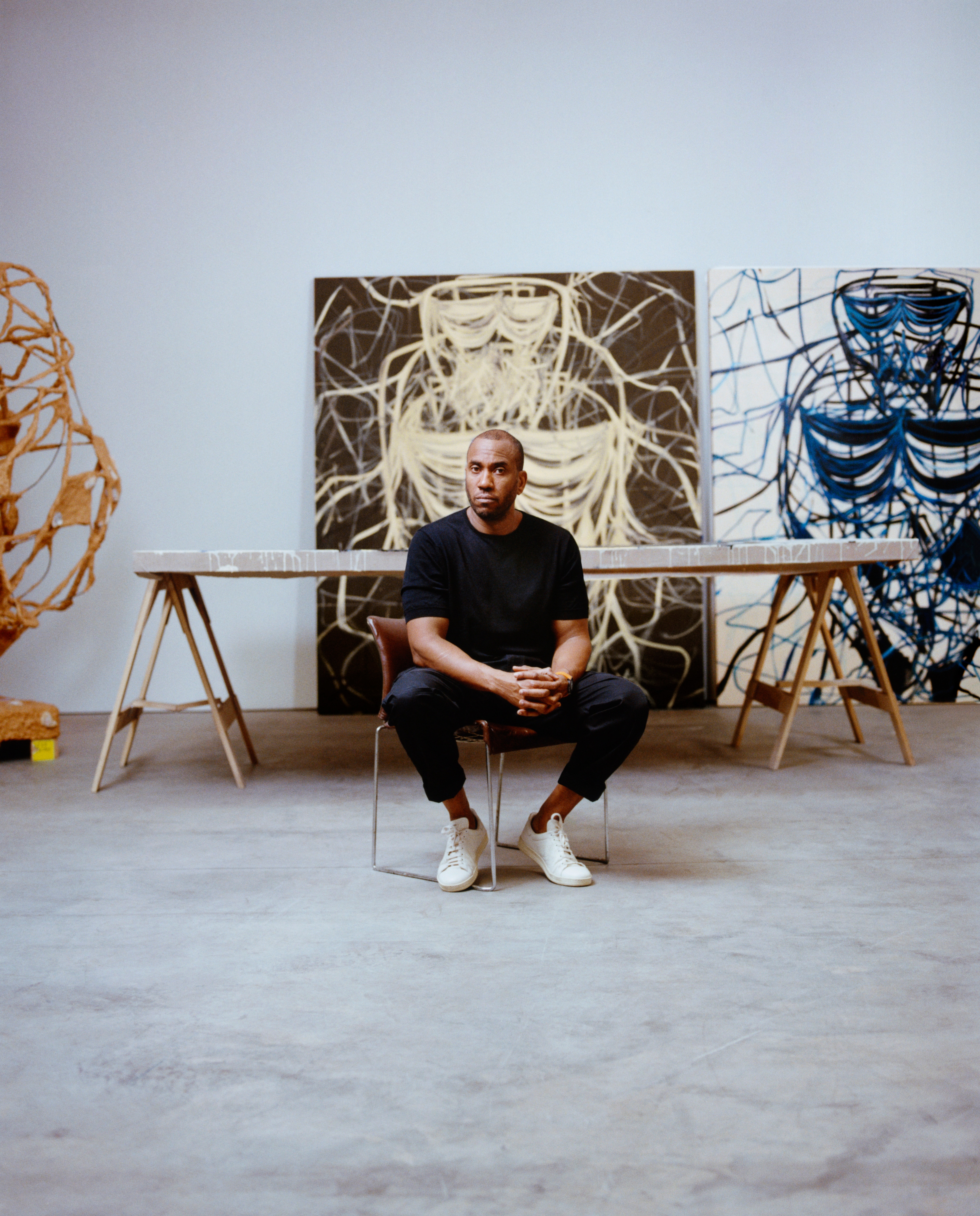Standing in the Solomon R. Guggenheim Museum’s famous rotunda, surrounded by three decades of his own artwork, Rashid Johnson feels like he’s at a family reunion. “I’ve always thought of art as something an artist gives birth to,” he tells Vogue ahead of his first solo show at the New York museum, Rashid Johnson: A Poem for Deep Thinkers (on view through January 18, 2026). With over 90 works, this mid-career traveling retrospective is also his largest exhibition yet. “When your art travels for a show like this, it’s like being a parent whose children have come back to find you. It’s rewarding, but also complicated.”
Much of Johnson’s work—and the experience of viewing it—could be described the same way. Never one to hide his emotions, the Chicago-born, New York–based artist is known for deeply personal and introspective pieces that explore both private and universal struggles. His Anxious Men series, which began a decade ago, started with a grid of white bathroom tiles—a nod to the tiled bathhouses he frequented in Chicago as spaces of community and healing. Onto these tiles, he applied a mix of black soap and wax, carving frenzied figures that reflect his anxieties about Black masculinity and fatherhood. Similarly, his Broken Men series uses shattered mirrors to symbolize self-reflection, inviting both the artist and the viewer to confront their own thoughts. For Johnson, making art is a form of release.
One of the earliest pieces in the Guggenheim show, Mudcloth (2001), fills him with nostalgia. Part of a series where he scattered materials tied to Black culture—like chicken bones—onto photosensitive paper, mimicking 19th-century photograms, the work reminds him of where he started. “I remember making it, the desperation and ambition I felt,” he says. “Seeing it now, I realize how much of my recent work connects back to it. It’s rewarding to know that even though I’ve grown, those early pieces still hold meaning for me.”
The exhibition avoids a strict timeline, instead offering a fluid journey through Johnson’s mind. Frank Lloyd Wright’s spiraling rotunda enhances the experience, with surprises around every corner—spray-painted text canvases, sculptures made with black soap and shea butter (materials tied to the African diaspora), and video works that showcase the full range of Johnson’s creativity.
For Johnson, working across different mediums has always felt natural. “In the mid-’90s, when I started, experimenting with photography, film, performance, or installation was just what you did,” he says. “I think we limit ourselves by defining ‘medium’ too narrowly. Consciousness itself can be a medium.”
[Installation view, Rashid Johnson: A Poem for Deep Thinkers]Rashid Johnson: A Poem for Deep Thinkers
April 18, 2025 – January 18, 2026
Solomon R. Guggenheim Museum, New York
Photo: David Heald © Solomon R. Guggenheim Foundation, New York
The heart of the Guggenheim exhibition is Sanguine, a sprawling, site-specific installation at the top of the rotunda. Composed of gridded steel structures, live potted plants, books by influential Black authors (a nod to Johnson’s love of literature—the show’s title comes from a poem by Amiri Baraka), and video works, Sanguine culminates in a film exploring Johnson’s relationships with his father and son. Suspended from the museum’s ceiling, full-sized palm trees and other plants appear to float mid-air.
“We haven’t seen bold gestures like this since before the pandemic,” says Naomi Beckwith, the Guggenheim’s deputy director and chief curator. “It’s thrilling to see the museum inspiring artists to take risks with its architecture again.” Beckwith co-curated A Poem for Deep Thinkers with Andrea Karnes of the Modern Art Museum of Fort Worth, where the exhibition will travel in March 2026 before heading to Chicago’s Museum of Contemporary Art.
“Rashid’s work beautifully echoes Frank Lloyd Wright’s vision of a museum alive with plants,” Beckwith adds. “Like Wright, Rashid sees the museum as a living space—not just a container for static objects.”
Tucked among Sanguine’s foliage is a piano, which will be played during performances throughout the show’s run. A stage designed by Johnson for the rotunda floor will host additional performances and public programs, organized with partners like the Academy of American Poets and Harlem School of the Arts.
“I’ve always been interested in creating platforms,” Johnson says. “As an artist, I’ve had my voice amplified—now I want to make space for others.” In 2022, his participatory installation Stage at MoMA PS1 explored the microphone’s role in protest and public speech. “This is a chance for me to learn from others’ perspectives.” (A former Guggenheim trustee, Johnson has also supported the museum’s internship program.)
With so much to absorb—from the layered symbolism of his work to the upcoming performances—Johnson encourages visitors to return. “Give me two days,” he says. “Two visits.”
Rashid Johnson: A Poem for Deep Thinkers is on view at the Guggenheim through January 18.
